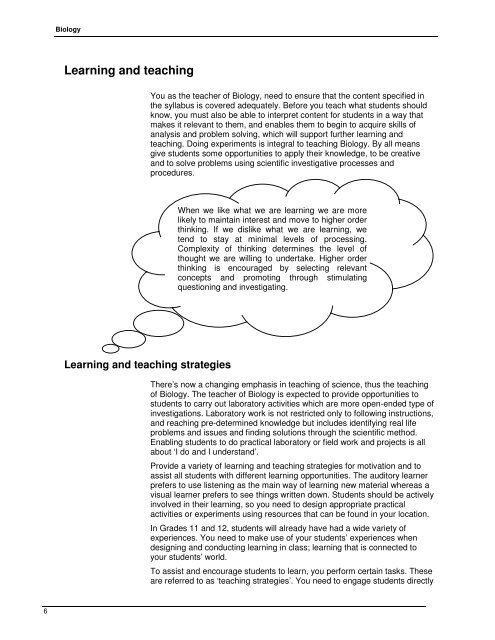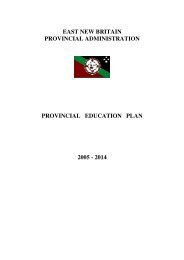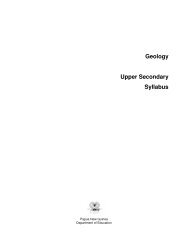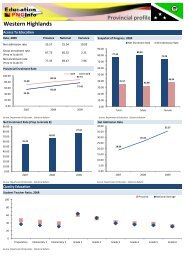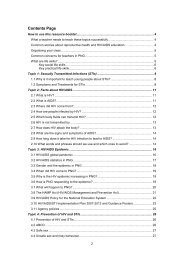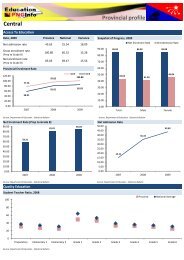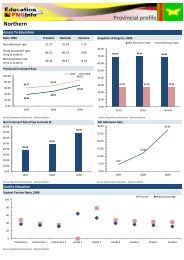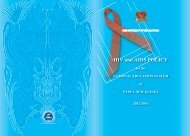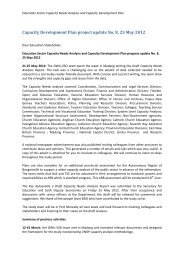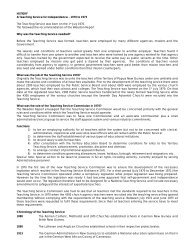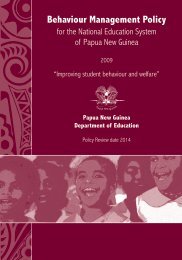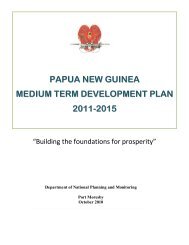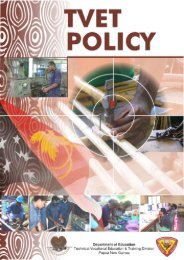Biology Upper Secondary Teacher Guide - Department of Education
Biology Upper Secondary Teacher Guide - Department of Education
Biology Upper Secondary Teacher Guide - Department of Education
Create successful ePaper yourself
Turn your PDF publications into a flip-book with our unique Google optimized e-Paper software.
<strong>Biology</strong>Learning and teachingYou as the teacher <strong>of</strong> <strong>Biology</strong>, need to ensure that the content specified inthe syllabus is covered adequately. Before you teach what students shouldknow, you must also be able to interpret content for students in a way thatmakes it relevant to them, and enables them to begin to acquire skills <strong>of</strong>analysis and problem solving, which will support further learning andteaching. Doing experiments is integral to teaching <strong>Biology</strong>. By all meansgive students some opportunities to apply their knowledge, to be creativeand to solve problems using scientific investigative processes andprocedures.When we like what we are learning we are morelikely to maintain interest and move to higher orderthinking. If we dislike what we are learning, wetend to stay at minimal levels <strong>of</strong> processing.Complexity <strong>of</strong> thinking determines the level <strong>of</strong>thought we are willing to undertake. Higher orderthinking is encouraged by selecting relevantconcepts and promoting through stimulatingquestioning and investigating.Learning and teaching strategiesThere’s now a changing emphasis in teaching <strong>of</strong> science, thus the teaching<strong>of</strong> <strong>Biology</strong>. The teacher <strong>of</strong> <strong>Biology</strong> is expected to provide opportunities tostudents to carry out laboratory activities which are more open-ended type <strong>of</strong>investigations. Laboratory work is not restricted only to following instructions,and reaching pre-determined knowledge but includes identifying real lifeproblems and issues and finding solutions through the scientific method.Enabling students to do practical laboratory or field work and projects is allabout ‘I do and I understand’.Provide a variety <strong>of</strong> learning and teaching strategies for motivation and toassist all students with different learning opportunities. The auditory learnerprefers to use listening as the main way <strong>of</strong> learning new material whereas avisual learner prefers to see things written down. Students should be activelyinvolved in their learning, so you need to design appropriate practicalactivities or experiments using resources that can be found in your location.In Grades 11 and 12, students will already have had a wide variety <strong>of</strong>experiences. You need to make use <strong>of</strong> your students’ experiences whendesigning and conducting learning in class; learning that is connected toyour students’ world.To assist and encourage students to learn, you perform certain tasks. Theseare referred to as ‘teaching strategies’. You need to engage students directly6


